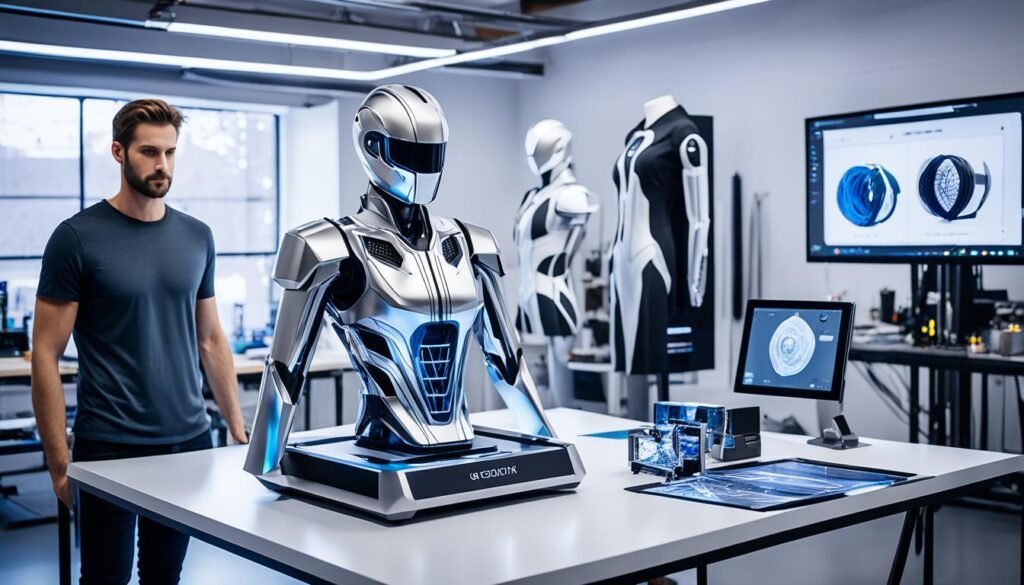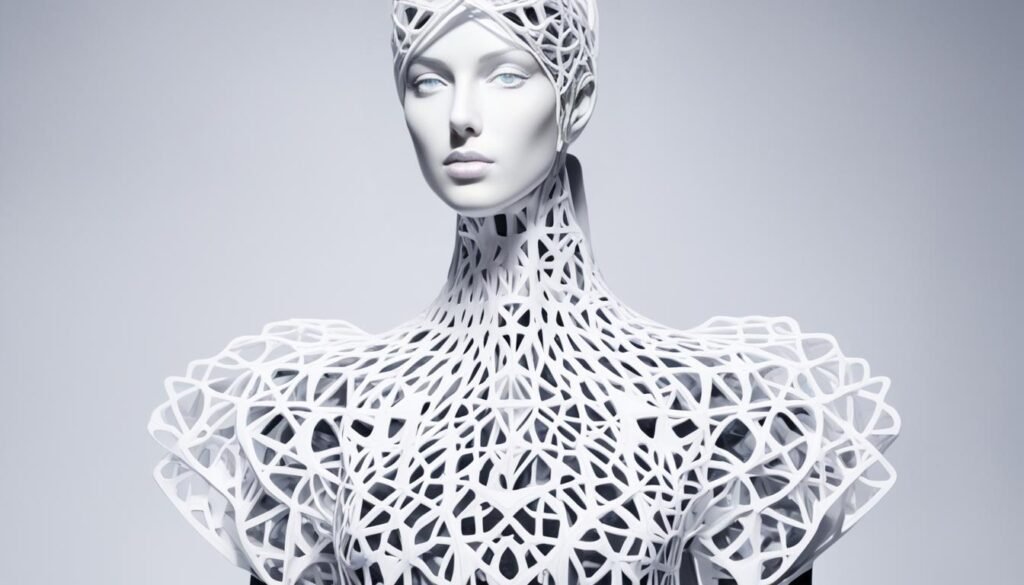In recent years, 3D printing has changed fashion design dramatically. Designers can now produce complex patterns and styles that were once impossible. This cutting-edge method promotes design creativity and tackles issues like sustainability and personalization.
Looking into this technology shows its potential to reshape fashion. We will explore how 3D printing is becoming a defining factor in the industry’s future.
Key Takeaways
- 3D Printing is revolutionizing the fashion industry.
- Additive Manufacturing allows for unprecedented design possibilities.
- It supports sustainable practices within fashion design.
- Customization meets convenience through advanced technology.
- Innovative techniques are paving the way for the future of style.
Understanding 3D Printing in Fashion Design
3D Printing in Fashion Design introduces a new way to create clothes and accessories. It uses additive manufacturing. This technique builds up materials layer by layer to make detailed designs. Designers can explore shapes and structures that were impossible before.
The Basics of 3D Printing
At its heart, 3D printing relies on building up, rather than cutting away, materials. It can use lots of different materials, like various plastics, metals, and bio-based substances. Each material offers unique advantages for fashion.
- Plastics: Lightweight and versatile, plastics are widely used for prototypes and final products.
- Metals: For high-end fashion, metallic materials provide durability and aesthetic appeal.
- Bio-based materials: These environmentally friendly options reflect a growing trend towards sustainability in digital fashion.
It’s key to understand these materials and how to use them. Doing so lets the fashion industry embrace 3D printing. It leads to exciting designs that also support sustainability.
How Additive Manufacturing is Changing the Fashion Landscape
Additive Manufacturing is leading a big change in fashion. It’s changing how we make clothes from the ground up. Old ways needed making lots of items at once, which wasted materials and made it hard to change quickly. Now, we can make clothes as needed, showing a big shift thanks to additive manufacturing.
Shifting Paradigms in Production
This cool technology lets designers dream up complex designs that were too hard before. With 3D printing, brands can quickly adapt to what people want. This means less waste and faster times from idea to final product. The perks are big:
- Less material thrown away, which is better for our planet.
- Making unique items or small batches is easier.
- Designs can be more creative and bold.
When companies use additive manufacturing, they find new ways to shake up fashion. This tech makes things run smoother and lets buyers have a say in what they wear. We’re at the start of something big. This change isn’t just cool—it’s necessary for making fashion sustainable.
| Aspect | Traditional Methods | Additive Manufacturing |
|---|---|---|
| Production Volume | High-volume, mass production | On-demand, customized production |
| Waste Generation | Significant material waste | Minimal waste through precision printing |
| Time to Market | Longer lead times | Rapid prototyping and production |
| Design Flexibility | Limited to standard designs | Unlimited design possibilities |
The Role of Digital Fashion in Today’s Industry
Digital fashion is changing how we see and use clothes. It combines creativity with new technology. Brands can now try out ideas without being held back by physical limits. On digital platforms, such as games and social media, virtual clothing gets a lot of attention. Techniques like 3D Printing in Fashion Design let designers create unique items in the digital world.
Blending Reality and Virtuality
Wearable Technology plays a big part in mixing the real with the virtual. People can choose special outfits for their digital avatars. This mix opens up new chances for both shoppers and companies. Using augmented and virtual reality, customers can see clothes in a more engaging way.
Fashion designers and companies are getting into this tech. It changes how they connect with shoppers. Digital fashion lets people try new styles freely. Brands that want to keep up need to know how to use tools like 3D Printing in Fashion Design.

Wearable Technology: Merging Functionality and Fashion
The blend of wearable technology with fashion is changing our style experiences. Innovations like smart fabrics are remaking the fashion world, mixing beauty with function. Now, thanks to 3D printing, designers can make unique clothes that meet the wearer’s needs.
The Evolution of Smart Wearables
Wearable tech includes gadgets that merge function with fashion, like fitness bands and smartwatches. These items are not just practical. They also fit personal fashion tastes. Let’s look at how this evolution unfolds:
- Adaptive Clothing: Clothes that adapt to temperature changes or movement for better comfort and function.
- Color-Changing Fabrics: Materials that change color based on the environment for unique personal style.
- Tech-Enhanced Accessories: Smart jewelry that brings together beauty and the latest tech.
The future is bright for wearable tech and tailored clothing. 3D printing’s role in fashion allows for custom-made pieces. These items satisfy both practical needs and style demands.
Rapid Prototyping: Accelerating the Design Process
Rapid prototyping in 3D Printing for Fashion Design marks a major shift. It brings new speed to the design process. Designers can quickly make prototypes for testing. This step-up is key for sparking innovation in fashion.
Benefits of Rapid Prototyping
Rapid prototyping offers many perks to fashion designers:
- Time Efficiency: It shortens the journey from idea to actual product. This allows for faster collection launches.
- Cost Reduction: Early tweaks reduce waste and save money over time.
- Enhanced Creativity: Designers can try out new ideas without worrying about high costs. This leads to more creativity.
- Improved Feedback: Getting opinions on prototypes helps make better final products. Designers can improve based on what people think.
Rapid prototyping using 3D printing brings more than just new techniques to fashion. It promotes a creative and efficient culture. This is critical for standing out in today’s market.
| Benefits | Description |
|---|---|
| Time Efficiency | It cuts down on design time, making for quicker updates. |
| Cost Reduction | It helps in cutting down costs by spotting issues early. |
| Enhanced Creativity | It pushes for trying out new and bold designs. |
| Improved Feedback | It allows for getting valuable advice from others. |
3D Printing in Fashion Design: Techniques and Innovations
3D Printing is changing fashion design by introducing new ways to make clothes. Innovations like selective laser sintering (SLS) and fused deposition modeling (FDM) have become important. These technologies allow creativity to flourish in Additive Manufacturing.
New Techniques in 3D Fashion Printing
Selective laser sintering creates detailed geometries that were once impossible. It uses powerful lasers to bond material particles layer by layer. This results in complex designs that make fashion items stand out. Designers use this for unique textures and light parts, making clothes both stylish and practical.
Fused deposition modeling builds objects layer by layer with melted thermoplastic. It’s known for its ease of use, offering designers many material and color options. This flexibility supports innovation in design. It allows brands to make custom clothes that are both special to the wearer and better for the environment.
Using these methods starts a new chapter in fashion. It leads to more personal and efficient clothing production. This significantly influences trends in the market. Here’s a comparison of SLS and FDM, showing how they differ and what they offer the industry.
| Technique | Material Used | Application | Design Capabilities |
|---|---|---|---|
| Selective Laser Sintering | Powdered Thermoplastics | Complex Designs | Intricate Geometry |
| Fused Deposition Modeling | Filament Thermoplastics | Accessible Prototyping | Customizable Shapes |

Embracing Sustainable Fashion through 3D Printing
The fashion world is changing, thanks to Sustainable Fashion and 3D printing tech. This new method is great for the environment and lets designers work smarter. It helps cut down waste and uses earth-friendly materials.
Environmental Impact of 3D Printing
3D printing can seriously lower waste in making clothes. Old ways made too much trash, leading to landfills. But with 3D printing, we only use what we need.
This tech loves recyclable and biodegradable stuff, which is perfect for eco-fashion. Leaders in the field are finding new materials that harm the earth less.
Making things closer to where people live is another 3D printing win. It cuts down on transport carbon emissions. This is a big move towards changing the fashion game.
The fashion industry is getting behind 3D printing more and more. This tech is not only eco-friendly but also sparks new creativity among designers and brands.
Customized Apparel: Personalization Meets Innovation
The fashion world is changing fast, thanks to 3D printing. This tech lets brands offer clothes made just for you. It means you can help design your outfits. This makes shopping for clothes a personal adventure.
The Future of Personalized Fashion
Creativity and personal style are getting a big boost. Wearable tech is getting woven into clothes, making them not just stylish but smart. This shift means brands have to be quick to catch up with what you want, putting custom clothes at the forefront of fashion.
Being eco-friendly and ethical makes personal fashion even more appealing. With customization, you get to wear something unique. And you support good practices in making clothes.
Conclusion
3D printing is changing fashion design in exciting ways. It allows for unique, geometric designs and wearable art. Brands like Adidas and ZER lead in creating sustainable, customizable fashion.
This innovative technology helps reduce waste and use resources wisely. Designers adopting 3D printing are guiding fashion towards a greener future. This shift could change how we view fashion, with a push for personal and sustainable choices.
The fusion of technology and fashion offers a bright future. It promises more customization and eco-friendly innovations. For more on 3D printing’s impact on fashion, check this sourced information.
